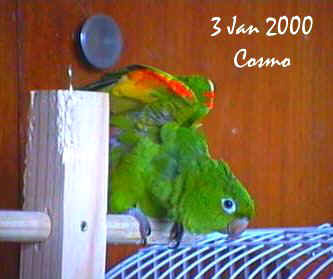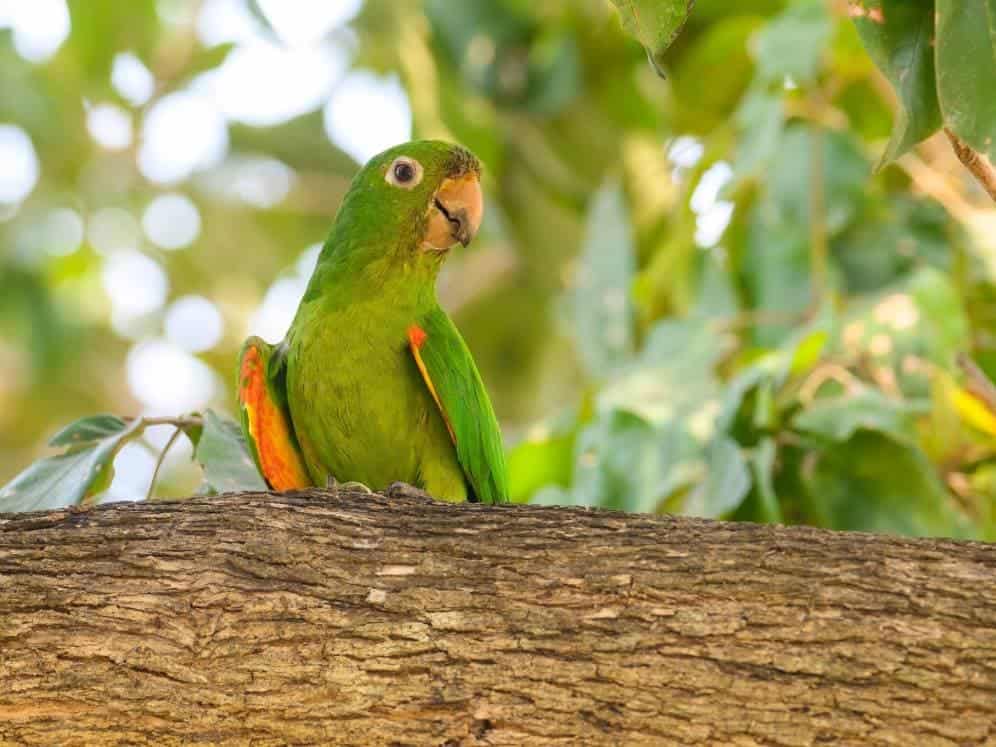
Here’s some comments from Comos’ keeper Cindy
“Cosmo is really cute – we can do almost anything with him. He’s starting to copy our Ringnecks and has a reasonable vocabulary at this moment. He does tricks and is getting the hang of staying in a place when we put him there. White-Eyed Conures make really good companions and are quick learners! Did I mention Cosmo is very loving AND adorable?!!”
For more information about the care of Conures see:
Guide to a Happy, Healthy Conure
- Kingdom: Animalia
- Phylum: Chordata
- Class: Aves
- Order: Psittaciformes
- Family: Psittacidae
- Genus: Aratinga
- Species: leucophthalmus
Scientific Name:
Aratinga leucophthalmus
Subspecies:
- White-eyed Conure
Aratinga leucophthalmus leucophthalmus - Peruvian/ Ecuadorian White-eyed Conure
Aratinga leucophthalmus callogenys - Argentinia White-eyed Conure
Aratinga leucophthalmus propinquus - Colombian White-eyed Conure
Aratinga leucophthalmus nicefori
Distribution:
These birds are native to much of northern South America, except the western seaboard. Ranges from eastern Colombia to the Guianas and southwards as far as Argentina and Uruguay.
Description:
Mostly green, with red feathers scattered over the head. Red and yellow plumage can also be seen on the wings, when they are held open. Irises are orange. In young birds the red feathers on the head and under the wings are absent.
Size – Weight:
These birds get up to 13″ (32 cm). Cosmo is exactly 32 cm long.
Care and feeding:
A roomy cage is required unless the bird is to be let out for extended periods. Many birds can spend most of their time on a play pen or parrot perch. They eat a variety of sprouts, seeds, nuts, fruits, vegetables, and commercial pellets, as well as the same nutritional foods humans eat.
See About Conures: Housing and About Conures: Care and Feeding for more information.
Social Behaviors:
In captivity these conures become very tame and will learn to speak. They need attention, patience, and toys.
Activities:
This bird loves to climb and play. This is your perfect chance to splurge on all kinds of climbing and chew toys.
Breeding/Reproduction:
They breed readily if they have the right size aviary. The hen lays three or four eggs which are incubated for about 26 days. The young fledge (leave the nest) after about 8 weeks. The nest box size should be 12″ x 12″ x 12″.
Potential Problems:
As with most Aratinga species, this type of bird can be noisy at times! See About Conures: Potential Problems for more information.
Availability:
This bird is generally available at a pet stores or breeders.
Featured Image Credit: FotoRequest, Shutterstock
